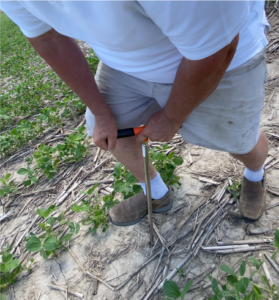Soil is one of our greatest natural resources and is at the source of nearly all the food we consume. Producers value their soil and are good stewards of the land. While they want to protect it, they also need to sustain productivity of their soil. Crops are living, breathing organisms that require sustenance – water, nutrients, carbon dioxide and sunlight – to live.
Soil itself is not a living organism, but it houses and can nurture a thriving community of microorganisms, insects and worms that also require sustenance-water, nutrients, oxygen, and carbon sources. Producers are very adept at managing their crops and now are seeking strategies to also manage this vast array of organisms in the soil.
What do these below-ground organisms provide? They break down organic matter, sequester carbon in the soil, release substances that stabilize soil aggregates and improve structure, all while mineralizing carbon and nutrients that are available to soil organisms and plants by releasing biostimulant molecules that stimulate the plant. The more active this community, the better the indicator that crops have a good environment to grow below ground.
One key principle in crop production was popularized by Justus von Liebig. This ‘Liebig’s Law of the Minimum’ states that a crop’s yield will be determined by the most limiting nutritional element. We can often see, or easily identify, several factors that adversely affect crop growth and development including weather, plant population, weed competition and pest infestations.

There are many other not so apparent factors like nutrient levels in the complex growing environment. Soil health may be the most critical limiting factor to productivity. Soil is not only there to anchor the plant and provide access to water, it also contributes significantly to nutrient availability, root growth and overall plant health.
Farming the soil begins with understanding the basic building blocks of soil health, measuring relevant indicators of soil health and deploying practices that improve soil health.
The first step is to evaluate soil quality by monitoring soil indicators such as organic matter, pH, salinity (electroconductivity), bulk density, water infiltration and nutrient levels. In addition to physical and chemical properties, healthy soil must also sustain high levels of microbial activity.
The second step in determining soil health is to assess the microbial activity. Today there are companies that sell soil sampling tests that assess and describe microbial activity and its output. These tests include measuring soil respiration or carbon mineralization, nitrogen mineralization, availability of active and soluble carbon, aggregate stability as well as microbial characterization. These soil tests have become common with recognizable names that include Solvita, SLAN, ISNT, Haney, Cornell, and PLFA. More recently, newer soil sample testing procedures have been developed to evaluate the soil microflora to identify the various organisms and their functions.
The third step is to adopt farming practices and products that optimize these key soil health indicators. Many agronomic practices can work to improve aeration, increase organic matter and microbial feedstock, thus enhancing microbial activity. The three most common practices are:
-
-
-
-
-
-
- Adopting conservation tillage or no-till
- Planting cover crops to reduce erosion and provide biomass in the rootzone
- Applying animal manures and compost to improve organic matter and nutrient density
-
-
-
-
-
Additional practices include:
-
-
-
-
-
-
- Increasing the number of crops grown on that field in rotation
- Considering the use of a biological product to stimulate and enhance the microbiome, feed the microbiome, shift the microbiome, and finally, leverage the microbiome to provide supplemental nitrogen or to improve phosphate availability.
-
-
-
-
-
Key takeaway: Improving microbial activity in soils and harnessing its output will enhance soil health and crop production.
For more discussion about soil health, contact Dan.Davidson@agrithority.com


